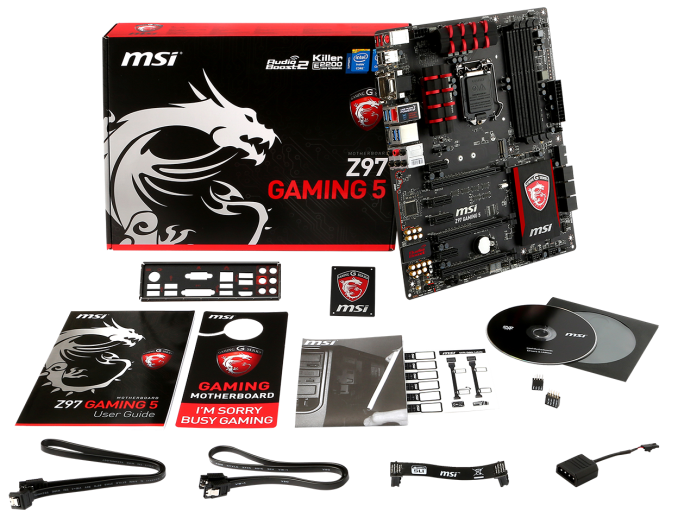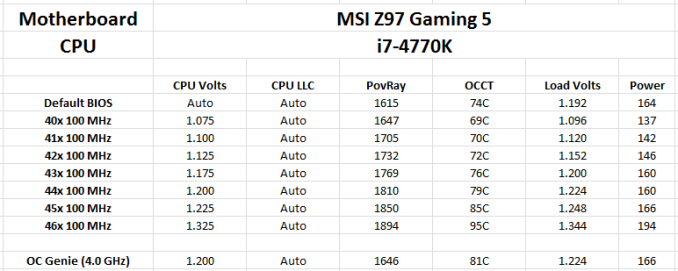MSI Z97 Gaming 5 Motherboard Review: Five is Alive
by Ian Cutress on October 6, 2014 10:00 AM EST- Posted in
- Motherboards
- Intel
- MSI
- Z97
MSI Z97 Gaming 5 In The Box
A gaming branded motherboard has the opportunity of offer a different experience to other motherboard segments. PC Gaming is growing, partially fuelled by popular games and increased resolution sizes driving GPU sales, and MSI’s ‘Gaming’ ecosystem aims to cater for as much as the market as MSI can manage. From the motherboard perspective, aside from the styling, having gaming related box bundles can turn a regular purchase into one that users might suggest to others. The only downside of this is the cost – placing plenty of gaming extras might move the motherboard into a price segment it cannot compete in. At the super high-end, some motherboards get game bundles, but at $148 there is not much room to maneuver.
In the MSI Z97 Gaming 5 we have:
Driver Disk
User Guide
Rear IO Shield
Quick Start Guide
Cable Labels
MSI Gaming Door Hanger
MSI Gaming Series Case Badge
Quick Connectors for the Front Panel
Two SATA Cables
Flexi SLI Bridge
Audio Power Adapter
Here we come across another problem with Gaming motherboard bundles. Features like the door hanger and case badge are interesting to have, but ultimately do not add functionality to the system aside from promoting the use of MSI products. Only having two SATA cables is an oversight – while it caters for an SSD + HDD combination, the minute an ODD is added or a second storage device, more cables are needed.
Many thanks to...
We must thank the following companies for kindly providing hardware for our test bed:
Thank you to OCZ for providing us with PSUs and SSDs.
Thank you to G.Skill for providing us with memory.
Thank you to Corsair for providing us with an AX1200i PSU and a Corsair H80i CLC.
Thank you to MSI for providing us with the NVIDIA GTX 770 Lightning GPUs.
Thank you to Rosewill for providing us with PSUs and RK-9100 keyboards.
Thank you to ASRock for providing us with some IO testing kit.
Thank you to Cooler Master for providing us with Nepton 140XL CLCs.
Test Setup
| Processor | Intel Core i7-4770K ES 4 Cores, 8 Threads, 3.5 GHz (3.9 GHz Turbo) |
| Motherboard | MSI Z97 Gaming 5 |
| Cooling | Cooler Master Nepton 140XL Corsair H80i Thermaltake TRUE Copper |
| Power Supply | OCZ 1250W Gold ZX Series Corsair AX1200i Platinum PSU |
| Memory | G.Skill RipjawsZ 4x4 GB DDR3-1600 9-11-9 Kit |
| Memory Settings | 1600 9-11-9-27 1T tRFC 240 |
| Video Cards | MSI GTX 770 Lightning 2GB (1150/1202 Boost) |
| Video Drivers | NVIDIA Drivers 337 |
| Hard Drive | OCZ Vertex 3 256GB |
| Optical Drive | LG GH22NS50 |
| Case | Open Test Bed |
| Operating System | Windows 7 64-bit SP1 |
| USB 2/3 Testing | OCZ Vertex 3 240GB with SATA->USB Adaptor |
MSI Z97 Gaming 5 Overclocking
Experience with MSI Z97 Gaming 5
MSI’s overclocking regime starts with OC Genie for an easy one-button overclock. Our thoughts on OC Genie have been relatively consistent over the last few generations – offering only one automatic overclock is easy to use but for those users who want a bit more without manual overclocking, it might be a little short sighted.
Manual overclockers should be pleased with MSI’s BIOS adjustment for Z97, giving overclocking options in a nice ordered list compared to a run-on list with no order. The use of Simple/Advanced modes also helps.
In our tests, we found OC Genie on an i7-4770K to come up a little short. It offered a 4.0 GHz overclock, which is only 100 MHz above stock operation. With a multi-stage OC Genie, we might have seen 4.0 – 4.4 GHz for those CPUs that can perform. For manual overclocking, we achieved 4.6 GHz, although it must be noted that the stock voltage was quite high.
Methodology:
Our standard overclocking methodology is as follows. We select the automatic overclock options and test for stability with PovRay and OCCT to simulate high-end workloads. These stability tests aim to catch any immediate causes for memory or CPU errors.
For manual overclocks, based on the information gathered from previous testing, starts off at a nominal voltage and CPU multiplier, and the multiplier is increased until the stability tests are failed. The CPU voltage is increased gradually until the stability tests are passed, and the process repeated until the motherboard reduces the multiplier automatically (due to safety protocol) or the CPU temperature reaches a stupidly high level (100ºC+). Our test bed is not in a case, which should push overclocks higher with fresher (cooler) air.
Overclock Results:
The high voltage at stock lead to a severe drop in power consumption if users are willing to adjust the voltage manually.












45 Comments
View All Comments
gw74 - Monday, October 6, 2014 - link
also, who said anything about "mainstream"? anandtech is a website written by enthusiasts for enthusiasts, and noobs interested in future-proofing like me. your point is?Salvor - Monday, October 6, 2014 - link
While I am definitely an enthusiast, I'm also not rich, and could never justify wasting money on the x99 chipset. At this point DDR4 is still to expensive to make sense unless you have money to throw away.ruggia - Monday, October 6, 2014 - link
well, you asked why would someone want it instead of DDR4.So he replied: mainstream
Did you meant to say why would an enthusiast want it?
Teizo - Tuesday, October 7, 2014 - link
Enthusiast means educated. It doesn't necessarily mean wasting money on unnecessary parts.gw74 - Tuesday, October 7, 2014 - link
(a) There will be a time when DDR4 will be essential and value for money. that is not today. (b) There will be a time quite soon when DDR4 is more common and slightly cheaper than now but still not strictly necessary for today's games, but buying it will be cheaper than buying DDR3 now and replacing with DDR4 later. the rational buyer would buy at that point. My question is will that point ever come and when do you think it will come?Nite Owl - Monday, August 24, 2015 - link
I thought an enthusiast was some one that was enthusiastic about cool new stuff and likes to build. No where in "enthusiast" does it say you have to pay loads of money and get ripped off on bran spanking new tech. your 3k tower is going to cost me 1500 next year! Mean while my setting are just as high as yours and well above 30fps... lol @ suckers! =PC'DaleRider - Tuesday, October 7, 2014 - link
LOL at the future proof comment. The ONLY way to future proof yourself in computers is not to spend your money.gw74 - Tuesday, October 7, 2014 - link
it's not binary choice of futureproof or not futureproof. better futureproofing. parts which will play newest games at highest settings per dollar without needing replacement for longest time. perhaps futureproof is the wrong word. how about "maximum longevity per dollar". bootable PCIE SSD, DDR4, 1440p, 802.11ax, CPU pipeline, GPU pipeline, and choose when to buy based on release dates/cost curve of these.spidey81 - Tuesday, October 7, 2014 - link
It's been proven time and again that the best way to "future proof" a gaming rig in particular is spend up on the GPU. With the current crop of Intel CPU's you're only seeing minor performance improvements in compute capability. I know plenty of people still using sandy bridge processors for gaming and multipurpose systems. Also, the biggest benefit from DDR4 will be for rendering, transcoding, onboard graphics, and the like. Games show little benefit from increased RAM speeds. PCIE gen 3 is the best interface we'll see for some time to come and x8 speed will be enough bandwidth for decent dual GPU setups. Anything more than that you'll be spending enough to justify an X99 platform.niceyuk - Saturday, November 1, 2014 - link
Theres no such thing as future proofing.